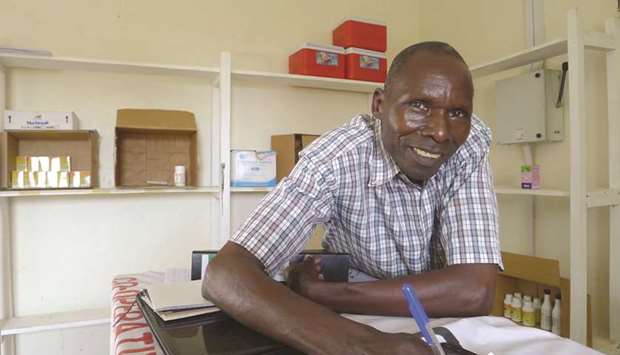Joyce Abiro was among the first to join the Katine farmers’ co-operative in 2010.
She’s since been able to take out loans to buy seeds and equipment, store what she produces in the community warehouse so that it keeps dry and clean, and sell her crops when the price is right.
This has allowed the 52-year-old, who lives in Ajobi village, to send her children to school, pay any medical bills, and build a more secure brick house for the family.
“I can produce [crops] and have a place to sell them. The co-operative gives me a market for my produce,” says Abiro.
“I was able to build that brick house,” she says, pointing to a structure in the centre of her compound, which she shares with her husband, mother-in law, and six of her 10 children. “Before, I was living in a mud hut.”
The Katine Joint Farmers Co-operative Society was established to improve the quality and quantity of food produced in this rural sub-county of northeast Uganda.
The co-operative also manages the 1,000-tonne capacity produce store, a whitewashed brick building, officially opened in 2011, which sits beside the main road that cuts through Katine on its way north to Lira.
The co-operative, and the produce store, are arguably the most successful examples of a development project launched 10 years ago with the support of Guardian and Observer readers, and Barclays.
In 2007, the Guardian and Observer began raising money through its Christmas appeals for two NGOs – the African Medical and Research Foundation and Farm Africa – to fund a three-year project to improve the lives of the 27,000 people who lived in Katine.
At the time, the sub-county had some of the worse health and living conditions in Uganda.
Katine had also suffered an attack by Joseph Kony’s Lord’s Resistance Army (LRA) a few years earlier, and been plagued by cattle rustlers.
The project, which was extended until 2013, led to the creation of village health teams, small microfinance programmes and farmers’ groups.
Healthcare workers were trained, schools built and boreholes dug.
The catalyst for long-term change, however, has been supporting farmers to produce better crops and, crucially, get them to market and sold at competitive prices.
The co-operative now has 876 individual members and 71 groups on its books.
In return for an annual fee, members are able to borrow and save money – the co-operative offers lower interest rates than banks – store excess produce and receive training and advice on growing crops.
A small shop on the premises allows them to buy equipment without having to travel to Soroti town, about 30km away.
Farmers also have the option to sell crops to the co-operative management team, which means they have a ready market and don’t get ripped off by middlemen.
Managers sell in bulk when the price is right, creating more profit to plough back into the co-operative.
Another fundraising effort by Guardian readers, in 2013, provided a £60,000 deposit fund at a local bank, ensuring that the co-operative had additional funds to borrow against to build the business.
Through Farm Africa, which has continued to support Katine farmers, the co-operative is now involved in the FoodTrade east and southern Africa programme.
Last year, farmers involved in the scheme were among the winners of a contract to export green grams and groundnuts to Kenya.
The co-operative has also applied to supply produce to the UN World Food Programme – unthinkable a decade ago.
“Katine is now famous in the area,” says Mary Aleto, general manager of the co-operative since 2014. “Now the farmers are happy because services have been brought nearer to them. They are able to bring crops to us, to avoid middlemen, and market their produce.
“Farmers’ standard of living is higher, people have taken loans to build houses … [they are] able to improve their produce now, able to increase productivity and get the right fertiliser. People are able to educate their children.”
When drought hit the region last year and crops were invaded by armyworm, the co-operative provided a lifeline.
“My family never went hungry,” says John Opio Eluru, who manages the co-operative shop.
He had grown and stored crops so that, when difficult times came, he had “enough to meet [school] fees and [pay for] medical care and feed everyone at home, so we could manage the drought”.
Life in Katine remains challenging and the co-operative’s success is only a small step.
Poverty levels are still high.
The largest medical facility, Tiriri health centre, remains understaffed and, while the operating theatre now has water, it is still without a regular electricity supply.
The fridge at Ojom health centre, already fixed once, has developed another fault and can’t store vaccines.
But having money in the community has created a buzz and optimism for the future.
Abiro has put some of her profit from selling crops into her co-operative savings.
Last year’s drought meant she had to uproot her cassava early to eat, but she says she had the resources to buy and sell other crops to make money.
“Before the co-operative it was not fine, not like it is now,” she says. “After the co-operative came in we got knowledge about how to save money in groups.
“There was no market for our product, compared to now. We could take things up to [market in] Soroti but now the market is here.”
And, she adds, if she gets sick she doesn’t need to worry about long queues or drug stockouts at the health centres. “I can afford to go for private treatment.”

My family never went hungry, says John Opio, manager of the produce store in that has brought significant benefits to farmers in the Ugandan sub-county of Katine.


